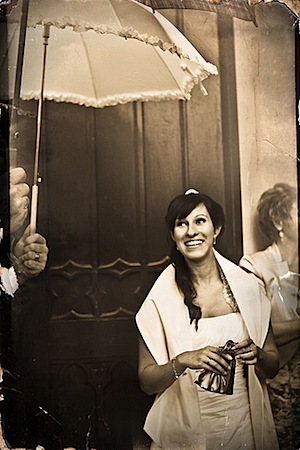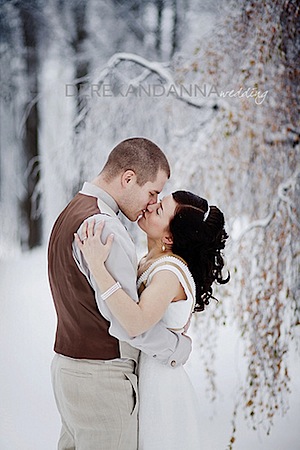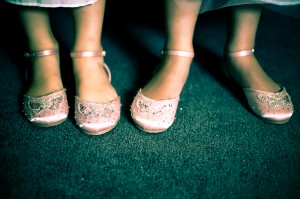Preparation

Image by Sean Molin
One of the most important steps a wedding photographer can do before a wedding is prepare themselves for all eventualities. Firstly this means meeting with the bride and groom and setting in concrete what it is the couple want and don’t want so there can be no confusion down the line; this will also be the time to establish a fee and contract with the clients.
Next you should visit the ceremonial venue and reception venue a week or two ahead of time to mentally place where the romantic portraits and group shots can be taken. Take into consideration where the light will be coming from at the time of day you’ll be shooting (hence why you don’t want to do a reconnaissance mission too far ahead of time) and also have a contingency plan if the area doesn’t work for whatever reason, as well as having an indoor backup if it rains.
The day before the wedding, mentally run through everything the couple wants as well as any ideas you envisaged during your pre-shoot scout. Fully charge the camera and flash gun batteries and format memory cards. Insert these into your equipment the night before and take a few test shots to ensure everything is working as it should be. Prime your camera with the settings you expect to use at your first shoot – which will most likely be the bridal preparation.
Kit considerations
Although you’ll want to take a range of accessories for every eventuality it is a good idea to travel light. The minimum a photographer should pack in a medium size camera backpack is: a favourite DSLR and back up DSLR, a flash gun with diffuser, a reflector, several memory cards each holding a capacity of around 2-8GB, lens cloth, raincover or carry bag to protect your camera in the rain and a lightweight tripod. If you have the room, strength and skills you may also want to take a selection of lighting equipment, filters, a laptop, pocket wizards, remote controls and props.
Lens choices
In terms of lenses there are three types that we would suggest are essential for a wedding, but if you are doing this as a favour for a friend or for your own portfolio then you’ll be able to get by using one or two zooms that cover a wide focal range – for example 18-200mm would be ideal. However if you are looking to exert a more professional edge you should probably invest in a wide-angle lens for the group and location shots – ideally something like a 16-80mm zoom lens will be perfect and covers a range of bases.
It’s a good idea to invest in a prime lens for portraits and images of all the smaller yet hugely significant items such as: the rings, party favours, flowers, bridal accessories etc – so a 35mm, 50mm or 80mm would be ideal. Finally a healthy telephoto zoom lens will allow you to capture those spontaneous ‘moments’ that people treasure because they show the subject as being ‘real’ . Using a telephoto such as 55-200mm will allow the photographer to ‘snipe’ shots from a distance without being detected, thus the subjects are totally relaxed and the result will be completely natural.
Camera Settings

T
here are no hard and fast rules to adopt in terms of learning what aperture/shutter speed combination to use for which occasion, as it will largely depend on what quality and quantity of light is available at that time, as well as focusing more on the ‘moment’ rather than getting the right technique.However as a guide, many photographers generally prefer to use some of the following apertures as a rule of thumb, but you shouldn’t be afraid to try something different if it suits the style and purpose of what you want to achieve.Church and indoor ceremonial establishments can tend to lack enough natural light and as most venues won’t permit flash push the ISO as much as possible before it starts to degrade image quality and if appropriate consider using a tripod (just remember to turn the VR off if you do). Opt for a fast lens and don’t be afraid to use a wide aperture even as low as 1.4 or 2.8 to make the most of what light is there. Use the same aperture for the small yet significant items such as the rings and bridal accessories, thus softening the background but generating enough depth of field to render the subjects nice and sharp.F5.6 for candid shooting and the romantic portraits will again keep the subject in focus yet blur distracting background detail. However there are occasions when you might prefer to slip into shutter priority, for example to capture the bride throwing the bouquet or children chasing each other around the venue - for these occasions (depending on the light) a speed of 1/250 will lend itself for creating some charming results.Depending on the number of guests that the couple want to appear in the formal group shots, you’ll be best using an aperture of between f8 and f11 to keep everybody pin sharp – depending on the quality of your lens this may mean pushing the ISO or incorporating a tripod. For pulled back compositions of the couple within the venue grounds and location shots in general you’ll need an aperture of between f9 and f11 to keep everything in sight in focus.Finally for those end of the night dance images either use a long shutter (with some form of stability) to generate movement within the photo and for capturing waves of light from the DJ’s lighting rig, or employ a flash to freeze the action using an aperture of your choosing to compliment the effect you wish to achieve.
Read more: http://www.digital-photography-school.com/wedding-photography-101-1#ixzz1IBl7KoTT























 As well as capturing the important stages of the day such as: bride and groom preparation, the ceremony, romantic portraits, candids, group shots, speeches and the first dance, you should use any time between these events to record the smaller – yet hugely significant details; in essence – anything the bride and groom have spent time and money on choosing for their big day.
As well as capturing the important stages of the day such as: bride and groom preparation, the ceremony, romantic portraits, candids, group shots, speeches and the first dance, you should use any time between these events to record the smaller – yet hugely significant details; in essence – anything the bride and groom have spent time and money on choosing for their big day.
























